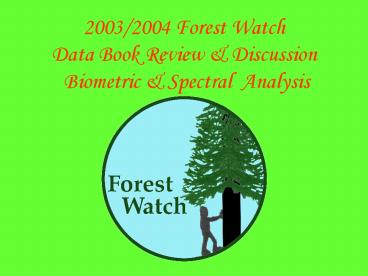2003/2004 Forest Watch - PowerPoint PPT Presentation
1 / 23
Title:
2003/2004 Forest Watch
Description:
2003/2004 Forest Watch. Data Book Review & Discussion. Biometric & Spectral Analysis ... by Forest Watch students and UNH researchers. ... – PowerPoint PPT presentation
Number of Views:140
Avg rating:3.0/5.0
Title: 2003/2004 Forest Watch
1
2003/2004 Forest Watch Data Book Review
Discussion Biometric Spectral Analysis
2
Figure 1
New FW Teachers Trained 2001 25 2002
14 2003 20 2004 31
2004 New Forest Watch Schools By State NH
13 DE 2 ME 1 CT 4 PA 1
3
Distribution of Active Forest Watch Teachers
Schools
Total 220 Teachers
Total 167 Schools
4
Ozone Conditions in New England , 2003 and
Historic
Bad Ozone Day for New England June 25 2003
5
Averaged 4 highest 1 hour ozone concentrations
The number of 1hr exceedances for 2003.
Many stations recorded zero exceedances in 2003
at the 1hr standard. Southern New England,
especially coastal areas were the only exceptions.
6
Graph of the Number of Exceedance Days in New
England from1983-2004 Based on the 8-hr
standard. Source http//www.epa.gov/region01/ec
o/ozone/standard.html
2003 2004 both had the fewest exceedance days
in over 20 years.
7
(No Transcript)
8
Figure 25 Number of ozone 1-hr and 8-hr
exceedances, compared to the number of days with
temperatures greater than 90ºF, as measured at
Bradley Airport outside Hartford, CT.
9
- Contributions of Ozone Precursor
- Pollutants in New England (2002)
- The automobile is directly and indirectly
- responsible for more than 50 of emissions of
- VOCs and NOX in New England.
- Steps we can take as individuals
- Hybrid technology!
- Less driving on hot days
- Public transportation
- Regular vehicle maintenance
- Avoid gas fill ups during hot weather
10
- The inverse relationship between REIP and ozone
returned in 2002 and 2003. - In 2003, high REIP values corresponded to low
ozone values as they have in most years - since Forest Watch began.
- In 2003 we saw our highest REIP values since
Forest Watch began. - Spearmans coefficient of correlation
(1998 -0.81) (2002 -0.39) (2003 -0.51) - Probability 1998 lt0.05 2000 lt0.20
2003 lt0.05
11
(No Transcript)
12
13
(No Transcript)
14
Average Annual Red Edge Inflection Point for All
Schools
- The overall trend shows increasing REIP values
between 1993 and 2003 - -Increasing CO2 in the atmosphere? (increased
rate of DBH) - -Younger Forest Watch trees replacing older
ones? (resistance) - -Improvements in Air Quality? (Clean Air
Act Amendments of 1990)
15
TM 5/4 Moisture Stress Index
- TM 5/4 is a measure of water content.
- Lower TM 5/4 More water
- lt0.55 Adequate Moisture
- 0.55-0.60 Initial Moisture Stress
- gt0.60 Increasing Stress
- Our two highest REIP years for all schools in
1999 and 2000 were our lowest 5/4 years. - 2000 was very wet, 1999 was a significant drought
year, however spring conditions were very wet in
1999. - 2001 and 2002 were drought years TM5/4 values
increased signifying less water. - In 2003, cooler and wetter conditions led to a
slight decrease in 5/4 values
16
- NIR 3/1 Provides us with information about the
developmental status of vegetation - Values lt0.9 are indicative of young, rapid
growth - Values from .9 to 1.0 equal indicate slow
growth and maturity - Values greater than 1.0 signify increasing
senescence
- The trend of increasing vigor and young growth
correlates well with the - Rise in REIP values seen between 1993 and 2003.
- This trend could also be related to the loss of
older trees sampled in - Forest Watch And the corresponding increase in
younger more - sampling accessible trees.
- 1999 and 2000 show the lowest values in 3/1 and
5/4 index values as well as - High REIP values
17
Long Term Analysis of Selected Student Collected
Biometric Data
18
Figure 19 Average Yearly Needle Retention
1992-2003.
19
Figure 20 Average Annual Needle Fascicle
Length 1992-2003.
20
Figure 21 Percent of needles with both chlorotic
mottle and tip necrosis 1996-2003. This decline
in the presence of both symptoms correlates well
with the increase in REIP over time.
21
Figure 22 Average Needle Damage Length 1996-2003.
22
Figure 23 Average Percent Needle Damage
calculated by Forest Watch students and UNH
researchers.
23
(No Transcript)































